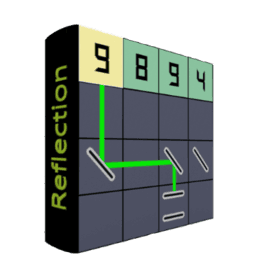laserreflection
 Reflection is a speed game where players must give other players a puzzle to solve and then be the fastest at solving other players' puzzles.
Reflection is a speed game where players must give other players a puzzle to solve and then be the fastest at solving other players' puzzles.
To create a puzzle, each player has the same elements to place on a grid (mirrors, black holes, etc.). The other players will only know in how many squares a laser projected from one end of the grid leaves the grid.
LB_NUMBER_OF_PLAYERS: 1 - 6
Game duration: 21 mn
Complexity: 3 / 5
Play laserreflection and 1194 other games online.
No download, directly from your web browser.
With your friends and thousands of players from the whole world.
Free.

Play laserreflection and 1194 other games online.
No download, directly from your web browser.
With your friends and thousands of players from the whole world.
Free.

Rules summary
Summary
Players create a puzzle using the allotted pieces then race to see who can complete the other puzzles the fastest.
Phase 1: Construction
Using all objects, each player places objects into the grid to create a puzzle that all other players will attempt to solve. All objects must be used and can be arranged in any way the player desires. When a player decides they are happy with the position of all objects they may select "ready" and prepare for phase 2.
Phase 2: Solving
When all players have completed their grids and pressed "ready" each player will receive the puzzle of another player. Players will then select "start" to begin solving the puzzle.
By placing objects on the grid, each player will need to deduce how the objects have been placed for this puzzle. To do this, the players must look at the numbers and colors on each square. If a square has a red outline that means that square's laser does not meet the requirements of reflection; the laser projected from that square does not project in the manner the other player set up with their puzzle.
A puzzle is solved when a player places objects so that all lasers for all squares meet their requirements.
Players will attempt to solve each other player's puzzle.
Players may "give up" at any time if they find a puzzle too difficult. They will proceed to the next player's puzzle after everyone finishes their own round.
Game Physics
Each square with a number projects a laser directly away from itself. The number is the amount of square that laser crosses before it exits the board.
Players may click on a numbered square to see the laser projected from it.
- Green squares project a laser that goes off the board through a different square than the one from which it started. This means that each green square will project a laser to another green square with the same number.
- Yellow squares emit a laser that reflects off a flat surface at some point and returns to the square from which it originally came.
- Gray squares emit a laser that is swallowed up in a black hole.
Examples:
- A Green 8 emits a laser that travels 8 spaces and leaves the board through another square.
- A Yellow 10 emits a laser that travels five spaces before it reflects off a flat surface and bounces back on itself covering the same 5 spaces (total of 10) and leaving the board through the same space it began.
- A Gray 4 projects a laser 4 spaces before it enters a black hole, where it stops.
Every numbered square will be one of the above.
Objects
Objects are randomized for each game. Games will not contain black holes or light warps unless specified in game preferences.
- Angled Mirrors: most common piece; reflects lasers at angles.
- Double Mirrors: two types: horizontal and vertical; create flat surfaces that send lasers back to their original squares; lasers passing between the mirrors are unaffected.
- Square Mirror: creates a four-sided mirror that reflects in every direction.
- Black Hole: creates a hole in which the laser stops and is absorbed.
- Light Warp: not placed by players, always two; creates a portal through which a laser passes; a laser entering through one light warp will continue out of the other.
Game End
The game ends when all players have solved their puzzles or given up.
Players receive points for solving the puzzle with the fastest player receiving the most.
After all rounds have been completed, the player with the most points wins the game. If players tie the one that took the least amount of total time across all rounds wins the game.
